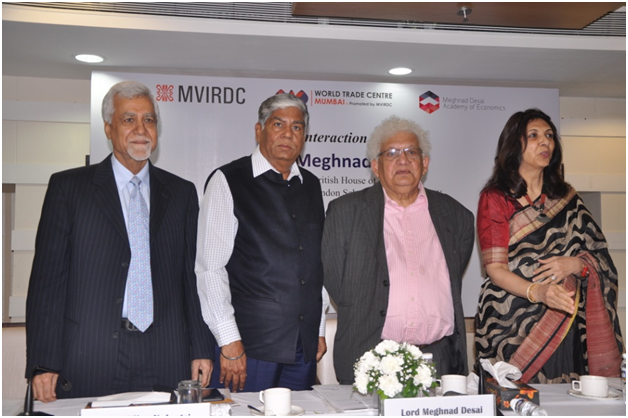“The failure of economists to anticipate the global financial crisis of 2008 and the ensuing recession in most parts of the world economy has underscored the need for a new approach to model and forecast business cycle,” said Lord Meghnad Desai, Life Peer, British House of Lords, Professor Emeritus, London School of Economics, UK during the interactive session ‘Hubris: Why economist failed to predict the 2008 financial crisis?’ jointly organised by MVIRDC World Trade Center and the Meghnad Desai Academy of Economics on 17th March 2015 at WTC. The Meghnad Desai Academy of Economics was introduced at the event.
Mr. Desai explained that a new theoretical and practical approach is required to understand the long-term business cycle, which is a combination of several short-term cycles. He gave the example of how the latest long-term cycle, which began after the 1970s oil price shock, involved several short-run cycles like the Latin American debt crisis (of 1980s), Asian financial crisis (late 1990s), dot-com bubble in early 21st century and the financial crisis of 2008. Modern statistical technique must be equipped to handle a large time-series of data to model long-run economic cycles, Desai opined.
He delved into the theme of his address by describing the paradox of the economists’ practice. He said the paradox is that in spite of several talented economists across the globe, they failed to predict the turning point (i.e. 2008 financial crisis that originated in the US).
He took the audience through a historical perspective of how economists from Adam Smith (1770 AD) to Paul Krugman (in 21st century), theorized the various business cycles in the world economy. He explained how the Battle of Waterloo spurred economic cycle when the government of the day spent heavily on defense, which led to the boom in the economy followed by a slowdown when the government slashed its spending (after the war). He also mentioned how Thomas Malthus and David Ricardo (early 1800s) differed on the dynamics of economic cycle following the war.

Further explaining the evolution of the theory of economic cycle, Desai said John Maynard Keynes (in the early 1900s) propounded the existence of dual equilibria – one in full-employment and another in under-employment. While David Ricardo was optimistic that the free market forces would ensure full-employment equilibrium, Keynes argued that market forces can also lead to under-employment equilibrium, thereby necessitating government spending to create jobs.
Talking about the modern day dynamics of the business cycle, Desai said the Keynesian boom in economic activity (after the Second World War) came to an end with the oil shock in 1973.
Desai also explained the role of credit in causing economic cycle by highlighting the debt crisis in the third world economies after the rise in the US interest rates in the 1980s. After 1973, price of crude oil rose remarkably in the international market, thereby enabling oil exporting countries to amass huge foreign exchange reserves. These countries, in turn, lent the foreign exchange reserves to developed countries, thereby leading to decline in the interest rate (in the developed countries) towards the end of the 1970s. However, interest rate started rising since the early1980s in the developed countries, which was one of the causes of the third-world debt crisis in the late 1980s.
Dr. Ajit Ranade, Chief Economist, Aditya Birla Group while announcing the introduction of the Academy described it as being a unique venture. Highlighting that economists are in demand across all business organizations, he was positive that the course curriculum to be offered by the academy would bridge the gap between academia and industry. While Introducing Lord Meghnad Desai to the audience he said that the latter is a ‘rare economist who wears a political hat’.
Dr. Indu Shahani, Dean, H.R. College of Commerce & Economics emphasized the need for a holistic approach towards teaching economics. Noting that today’s young economists are the likely future policy makers, she said a good curriculum on economics should have latest research techniques, data handling methods, good communication skills program and industry exposure. These features are included in the course to be offered by the Academy, said Dr. Shahani who will be part of the Academy.
Earlier in his welcome address, Capt. Somesh Batra, Vice Chairman, MVIRDC World Trade Center said that the lecture would provide an opportunity to hear, listen and absorb what Lord Meghnad Desai had to say on ‘why economist have failed to predict the 2008 financial crisis’.
Mr. Vijay Kalantri, Vice Chairman, MVIRDC World Trade Center and President, All India Association of Industries delivered the vote of thanks by praising Lord Meghnad Desai for his insights on economic cycles. He called him as the ‘man who speaks out of the box’. Although, economics mean different things to different people, what eventually matters is profit. He mentioned the specific problems faced by economies across the world like the debt crisis of the eurozone, slowdown in the Chinese economy and challenges in India’s manufacturing sector. He concluded that the current progressive policy environment in India may help in the economy reaching a size of US$ 20 trillion by 2040 from the current size of US$ 2 trillion as envisaged by PM Modi.

 : +91 7718886506
: +91 7718886506